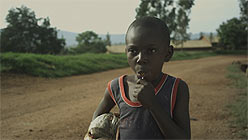I’ve never been to Africa, which may explain why movies about pretty much every corner of the continent seem to me both gritty and dreamlike. The dust, wind and heat are palpably real, yet somehow otherworldly. I feel as if I’m gazing into the past and the future at the same time. It’s a lovely, disorienting sensation, delivered with differing degrees of pathos by three seductive works in the San Francisco International Film Festival.
Jamaica-born, New Jersey-raised Alrick Brown’s dauntingly ambitious feature debut, Kinyarwanda (Get Movie Showtimes), takes its title from a language that practically every Rwandan, regardless of background, speaks. It’s something everyone has in common — Hulus and Tutsis, Christians and Muslims — and Brown means to suggest that the basic values that Rwandans share trump any perceived ethnic, religious or class difference. It’s an admirable sentiment but how much stock can we put in it given the rivers of blood shed during that terrible summer of 1994?

“Kinyarwanda”
Well, a good deal, actually, based on the fact-based experiences of the terrifying genocide recreated here. A young couple (he’s a Hutu and she’s the daughter of a Tutsi mother and a Hutu father), among others, navigate their way past and around the machetes to safety at a mosque. There’s a passing dig at the hotel manager immortalized in the film Hotel Rwanda, and Kinyarwanda — with its gravitas performances by Rwandan actors and actresses (and some non-professionals) — suggests a more authentic, less Hollywood view of events.
That said, there are some saccharine missteps with the soundtrack, an ill-advised use of slo-mo in a rescue scene and a jarring performance by the actress with a capital A who plays an important secondary character. At the end of the day, however, the fact that we leave the theater with a sense of hope and forgiveness proves that Brown’s optimistic title wasn’t so farfetched after all.




